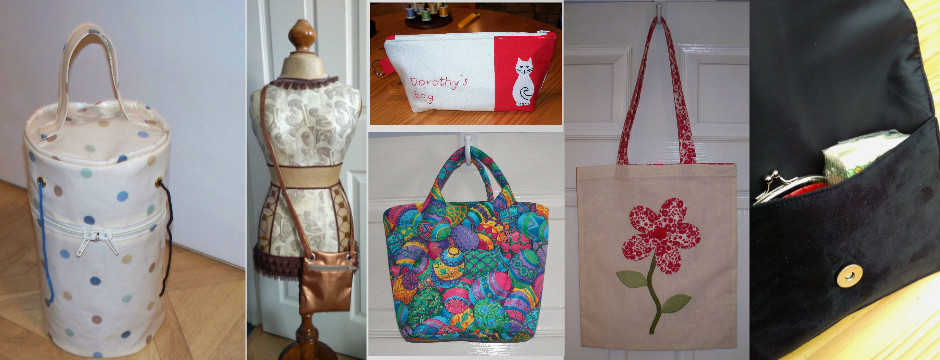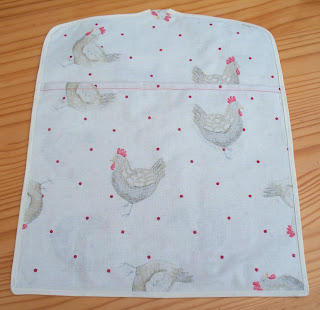This week I
wanted to make a bag for a man. Most of
the bags I have made so far have been quite feminine, but men need bags
too. I canvassed the men in my life for
their views about the type of bag they would use most. I got the obvious answers – laptop bag, gym
bag, messenger bag (watch this space for them in the not too distant future) –
but I was intrigued when one of them suggested a belt bag. I wasn’t even sure what a belt bag should look like. The
request was for a small bag to be attached to his belt so that he wouldn’t have
to carry it around and it should be large enough to hold a mobile phone and
small wallet. Well here it is.
I made it out
of a chocolate brown faux suede because most of my other fabrics are brightly
coloured quilting fabrics which wouldn’t have looked right. One of the key points stressed by my male
respondents was that they wanted their bags to blend in whereas my female
friends want their bags to stand out.
The brown would look good with jeans and wouldn’t show the dirt. And it
wouldn’t make them a laughing stock in the pub.
The finished
size is 5” x 7” and it fits over a 1½” belt.
The belt loop could easily be made bigger to suit a wider belt.
I made it with a foam stabiliser because I wanted quite a structured shape but wadding is much easier to use if you don't mind a softer shape.
I used ¼”
seams throughout. As the foam made the
seams really thick, I used a longer stitch length (3) for both the seams and
top stitching.
Skills used in this project:
- Using rivet snap fasteners
- Working with bag foam
- Designing a man's bag
For this project you will need:
- A 5 ½” strip of outer fabric, lining and foam (iron-on or sew-in)
- Scrap of interfacing (medium or heavy, sew-in)
- 2 rivet snap fasteners
Step 1: Cutting out
Cut out the
following pieces:
18” x 5½”
body (cut 1 outer fabric, 1 lining and 1 foam)
2” x 6½”
side panels (cut 2 outer fabric, 2 lining and 2 foam)
3½” x 5” belt
loop (cut 1 outer fabric)
3½” x 1¾”
interfacing for belt loop
Step 2: Attaching the fasteners
Pin the foam to the wrong side of the outer body fabric (or use an iron to join them if using iron-on foam).
Make a mark on the foam where each fastener should go. The fasteners
are attached to one of the short ends of the fabric. This should be 1¼” from top and side edge.
Make a hole in the fabric
and foam which is only just large enough for the prong of the fastener to pass
through – I used a tailor’s awl. Follow the instructions for your hardware - there are lots of different types of rivet fasteners and the fitting instructions vary. For most types you will need to push
the inner part of the fastener through the hole and attach to outer part using
the appropriate tool and hammer gently so that they are firmly attached
Repeat for
the other corner of this short edge.
Step 3: Making the bag parts
Pin the right
side of the lining to the right side of the outer fabric (which has the foam already
pinned or ironed to the wrong side). Sew
all round leaving a gap of approximately 4” for turning along one of the long
sides. Gently pull the fabric through
the gap so that the right sides are facing outwards and hand sew up the gap.
Top stitch along
the short edge where the fasteners have been attached (see image under step 6).
Trim 2 corners on one of the short sides of each side panel so that they are curved (the curves will go at the bottom of the bag). I drew round a coin to create a symmetrical shape. For each side panel, sew the lining, outer fabric and foam together as above.
Top stitch
along the short edge which does not have curved corners on each of the side panels. This will be the top edge.
Step 4: Making and attaching the belt
loop
Fold the
outer fabric in half, right sides together, so that the shorter sides
meet. Sew around one long and one short
side. Turn the fabric right side
out. You will now have a pocket. Slip the interfacing into the pocket. Turn
the ends of the remaining raw edge towards the inside and top
stitch the seam in place. Top stitch along the opposite side to create symmetry and to hold the interfacing in place.
The belt loop
with need to be in the centre of the bag, with the top of the loop 5” from the
end of the flap (the end which doesn't yet have fasteners attached). When pinning it in place,
pin the top and then put a finger between the top and bottom before pinning the
bottom. This allows some ‘give’ so that
the bag does not become misshapen when attached to the belt. Top stitch along
the top and bottom though all layers of the fabric.
Step 5: Assembling the bag parts
Pin the side
panels to the body, wrong sides together, starting at the top of the front of
the bag (the end with the fasteners already attached). The top of both parts has
already been top stitched. Curve the body
around the side panel, pinning it in place. Join them by sewing all round the
side panel.
Do the same
for the other side panel.
Top stitch
around the flap of the bag.
Step 6: Attaching the top fastener
The fasteners
are attached to the corners of the flap.
Make a hole 1” from the side and 1” from the end through all layers of
the fabric. The stud part of the
fastener goes on the right side of the outer fabric with the other part on the
lining side. Hammer them gently but
firmly together.
Do the same
in the other corner.
Congratulations! You have completed your belt bag. Slip a belt through the loop on the back and wear it with pride.
In this project I learnt:
- The rivet snap fasteners were easy to use once I had worked out which bits went together. I bought a kit with all the parts and tools but it didn’t come with any instructions. Why is that??? Anyway, I looked on the internet and found out how to do it. The first part went in absolutely fine. When I came to fixing the rivets on the flap at the end, one of them was a bit crooked. It still works but needs more pressure to fasten. I was a bit disappointed that the last step didn’t go quite to plan. I think I lost concentration because I was rushing to finish. Next time I’ll try to remember to give the hardware my full attention.
- The faux suede was easy to work with but not the bag foam. This bag’s design meant that the seams were really thick and my poor sewing machine struggled. Wadding would have been softer and easier to sew through. However the bag would have had less structure and I particularly wanted a very structured shape. A mistake I made at first was using my sewing machine’s normal stitch length which was totally unsuitable for that level of thickness. As soon as I increased the stitch length the machine coped better. Looking back, it’s fairly obvious, so I don’t know why I didn’t realise at the start.
- Designing a bag for a man required a completely different outlook. I’m glad I asked around for suggestions because it was interesting to hear a man’s viewpoint. When I suggested all the extras I love to include like pockets, zips, D-rings, they weren’t interested – all they wanted was something plain and functional. The words ‘not girly’ were used more than once, so perhaps peer pressure is a bigger concern than I thought it would be. I’d love to hear your views about what a man wants from a bag. Feel free to add a comment and help me to understand this alien species!















































